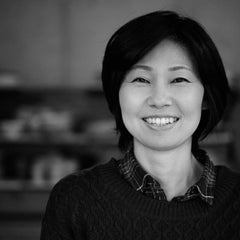Satoko Suzuki
The potter Satoko Suzuki has been creating ceramicware, together with her husband Yuichiro Suzuki, at their studio “Inima Tobo” since 1999. While they both trained in ceramics at Shigaraki, one of Japan’s six ancient kilns, their ceramic styles are different.

Satoko was born in Osaka and studied ceramics at Osaka University of Arts Junior college. She then did further studies in ceramics, specializing in potter’s wheel in Shigaraki, which is located near the historic centres of Kyoto and Nara. Shigaraki ware has a long history of pottery which started around the 13th century. It developed due to its location on a major road with readily available high quality clay. The traditional Shigaraki ware has a warm rustic texture from the local clay and has a beautiful natural appearance.
Satoko’s ceramicware has a natural style. She uses hard textured red clay and makes use of clay’s natural warmth in her works. Satoko chooses a different clayey soil for slip coating, which is applied prior to glazing. She creates her own color by blending a variety of ceramic pigments and colors. Satoko applies a slip coating to each ceramic item by hand. Then it is biscuit fired (the first firing of pottery) before glazing and glost firing (the final firing that adheres the glaze to the pot).

Because the colored slip coating is applied manually with a brush, its irregular color concentration through each brush stroke makes each ceramicware item unique. Satoko said that she likes the process of slip coating and the unique combination of texture and color on the rough clay.
Her natural tastes are derived from her own lifestyle. Satoko and her husband Yuichiro live with their two daughters in the artist village “Takumi no Mura” in Nara.
We saw beautiful autumn leaves from their big studio windows when we visited in November. The natural surroundings show the change of seasons. The air is clear, crisp and clean. She said that they experience temperatures below zero degrees Celsius in winter time, so clay stays frozen, even indoors. It is quite hard work to knead clay and she can’t hold the clay for long because it is so cold.

Life in a remote village is different from modern city life. Satoko recalled how new experiences confused her when they moved in. There are many old Japanese customs in this rural setting. There are fewer boundaries and deeper relationships. While it takes time, it is good to connect with people, she said. Living in a small village makes people in the community become family.
Her natural style of ceramics was born in this remote mountain.
While Satoko has been making ceramics for more than two decades, she realizes how ceramicware changes the taste of food or tea. She experienced hemiplegia (paralysis of one side of her body) a few years ago. She recalled that she could not properly taste food or drink tea in plastic tableware when she was hospitalized. Her husband, the potter Yuichiro, brought ceramic cups to the hospital for her. Satoko said that everything tasted much better in ceramic cups.
We eat and drink every day. We taste not only foods or drink. We taste whole experiences.
Satoko, a potter as well as a mother of two daughters, makes foods for her family every day. Her ceramics are crafted for daily use. The shapes and sizes of her ceramics come from her daily experiences of cooking for her family. Her approach is to create ceramics close to your daily life.
She is particular about texture and its expression in ceramicware. In her work, every brush stroke and every soft curve come together to make warm tableware.
Ceramicware is more than just a tool for consuming food or drink. Satoko wants to bring a truly warm experience to your table.


